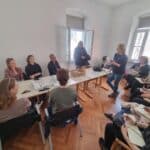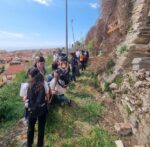The ZRS SCORE team, leading the Piran Coastal City Living Lab, received an invitation by the Council of the Local Community of Piran (Svet Krajevna Skupnost Piran) to discuss and visit a plot of land. The municipality, which owns the plot of land, as agreed for the local community to develop an action plan.
A collaboration between experts, students, and local actors
On 21 April 2023, the SCORE team joined a group of 30 landscape architecture students of the Ljubljana University’s biotechnical faculty and their mentors Dr. Marko Dobrilovič (and prof. Ana Kučan who was not present), together with several community members, a representative of the local action group involved in various community activities (Luka Čibej), and the host Sandra Loboda, Council representative.
The plot of land is an underused small stretch of land that is situated on the terraces just below the St. George’s Parish Church. These sloped terraces traditionally are enforced by dry-stone walls (recognized by UNESCO as intangible cultural heritage), that provide support to the soil and limit erosion and landslides. The students were supposed to map the piece of land in detail during the site visit. Access was limited as the dry-stone-walls protecting the terraces were in a severely degraded state.
Ecosystem-based approaches for the terraces
Before the visit, Deputy Mayor Manuela Rojec opened the discussions, and the participants talked about the different ecosystem-based approaches (EBA) that could be implemented on this plot, emphasizing the inclusion of restored dry-stone walling as an EBA. Based on the earlier findings within the CCLL, the preference went to upgrading the use of land towards a proper urban green area with the restoration of the dry-stone terrace walls, and the potential for the plot of land to retain precipitation water optimally, using specific vegetation and paying attention to – existing or potentially new – water ways. The discussions with the students raised very good questions and land-use insights.
They now have the assignment to prepare thesis work before the summer that encapsulates a new plan for the use of this particular plot of land. They will have to incorporate the wishes of the local community and the local action group, as well as the input shared by their teachers and the SCORE ZRS team.
This collaboration between experts, students, and local actors is at the heart of the Coastal City Living Lab framework developed by the SCORE project, and the ZRS team is very supportive of this initiative by the Local Community of Piran. A previous activity in Piran involved high school students in a field data gathering trip. The team is looking forward to discovering the new ideas sprouting from this collaboration!
More information about Piran Coastal City Living Lab can be found on our dedicated page.


